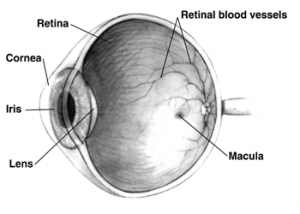The bionic eye was invented to help the blind see. In 1755, French physician and scientist Charles Leroy discharged the static electricity from a Leyden jar which is basically the modern day capacitors. Wires were used to go to the blind person’s body to help them trans mit light. This was the first time for a blind person to restore at least a flicker of visual perception. This is what the Bionic Eye is based off of and has the same concept of what Charles Leroy introduced.
mit light. This was the first time for a blind person to restore at least a flicker of visual perception. This is what the Bionic Eye is based off of and has the same concept of what Charles Leroy introduced.
Blindness is very big and effects about 40 million people worldwide. The bionic eye would substitute for lost photoreceptors. The Boston Retinal Implant Project, a team of scientists, engineers, and clinicians at research institutions across the U.S. are working to develop a retinal prosthesis that would be mounted on the glasses that would help transmit information to the eye. It would be using radiofrequency telemetry which is somewhat similar to radio broadcast. The signal goes through an implanted subretinal electode array from a cable which penetrates in to the eye.
The bionic eye will send pixels in the camera to the array of stimulating electrodes that are positioned in the eye. When that is placed in to the eye of a blind patient, it will act like the eye of a non-blind person. Devolving this device is long and hard. It requires a large of amount of knowledge of the retina and how prosthetic devices with interact with the retina. The most important thing is to know how the retina will react to an electrical charge. The topic of the bionic eye has only been a hot topic for scientists only in the recent years. They were first focused on how nerve cells respond to light and the normal vison function of a human.
MVG is directed by Professor Arthur Lowery of the Department of Electrical and Computer Systems Engineering. They are aiming to restore the sense of light to a blind person by using electrode arrays that will bypass the retina and optic nerve. Their goal is to help people do things they can not do with out a cane or a service dog. MVG is able to implant up to 473 electrodes with the first prototype of Gennaris. The bionic system would be able to possibly bring back 85% of blind people. There is a wireless transmitter that is attached to the person and it presents the image the person is looking at to a number of microchips. Phosphenes produce small flashes of light in 2 dimensional array.
The bionic eye is a very neat product that was invented to help the blind. It all started with back in 1755 with a Leyden jar. That gave an idea to the scientist today to see what they can do to help. For the longest time scientist were working on research for the normal person with normal vison to gain a better scope. Then in the last few years they turned the scope to do research on the blind eye to see what they can do to help and they are working on prototypes to help the blind see.What can we expect from the bionic eye in the next 10 years? How long is the object expected to last? What has to be done in order to get the bionic eye?
WOW! That was very interesting to read and to watch the video. At first I had no idea what a Bionic Eye is but as I continued reading I began to understand that it helps cure the blind, but it is not for everyone. Only those who are blind that is not connected to light vision would be able to benefit form the Bionic Eye. “The breakthrough is
likely to benefit patients with the most common cause of
blindness, macular degeneration, which affects 500,000
people.” I looked up the topic and this article helped with further explanation of how the eye works. http://www.met.edu/Institutes/ICS/NCNHIT/papers/05.pdf